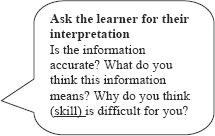Numerous quotes from successful adults with learning disabilities all share a similar message: "the key to my success has been to understand and accept my learning challenges". Two valuable lessons can be learned from their experiences. These lessons are applicable to all learners regardless of the presence of a learning disability:
- A learner cannot understand and accept their learning barriers unless they are an active part of the discovery process.
- Without a strong understanding of what is blocking our learning, we cannot develop effective learning and teaching strategies.

Tips for a successful journey
- Create an equal relationship right from the start
- Help learners to understand their potential learning disabilities
- Encourage learners to explore their own profile of strengths and challenges
- Help learners understand why they were having difficulties in the past
- Create an environment where making mistakes is a normal and essential part of learning
- Use a flexible approach
- Ask a variety of questions about the learner's work and/or learning strategies
- Encourage learners to be self-directed learners by encouraging independence right from the start3
- Encourage students to self-assess the way they learn and think
What are we looking for when we assess?
Potential learning disabilities are only one piece of the learning puzzle. The use of a
screening tool can be a valuable aid in the discovery process but the results should not be
considered in isolation. Although it is possible to assess for each of these barriers to
learning separately, it is important to understand that they are all interconnected.
Practitioners need to discover how adults learn information and where possible
breakdowns occur. "Because learning is multi-dimensional, it is important to understand
the relationships between these areas and how they function with each other to enable the
adult student to learn a given task."
4
3 Dyslexic Institute UK (2002). Best Practice for Adults. <http://www.dyslexia-inst.org.uk/pdffiles/adltprac.pdf>.
4 Sturomski & Associates (1997).